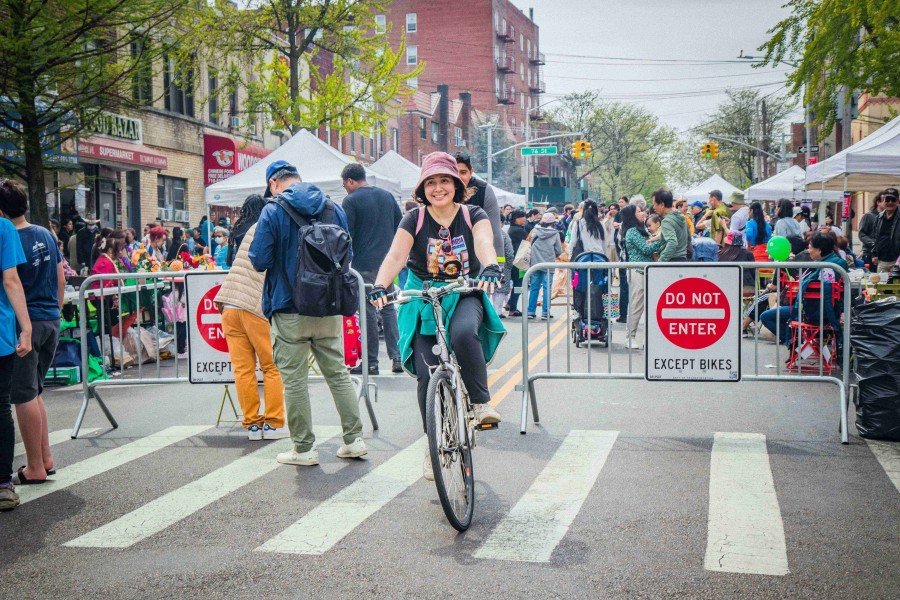A Greener New York, Washington Bridge Upgrades, and Better Bedford
The UN General Assembly meets this week, causing heavy traffic, road closures, and gridlock for many New Yorkers. As vehicles remain stuck in endless traffic – in a city that already suffers from the worst traffic in the nation – bike riders move quickly and safely through gridlocked First and Second Avenues on protected bike lanes. Just blocks from the UN, two of our city’s most effective bike lanes move thousands daily, and a new bike and bus lane on Third Avenue nears completion.
While world leaders discuss the future of our planet and cities, and as transportation remains one of the leading causes of greenhouse gas emissions globally and in our state, they need merely look out of the UN’s window to see a different path forward. On our most car-congested streets, pollution dirties our air, chokes our children, and destroys the environment. By building streets that put people first, we can help both our planet and population thrive with more space for pedestrians, protected bike and bus lanes, and trees.
As host to this annual event, and a leading global actor in the fight against climate change, New York City can and must take real action to reach its climate goals by advancing NYC 25x25 and reallocating 25% of car space to better use. With the City of New York legally required to complete the NYC Streets Plan and the onset of congestion pricing, we’re already well on our way.
Now, we need our leaders, especially in New York, to stop making empty promises and 2050 plans, and get to work delivering solutions today.
In support of NYC 25x25, some immediate solutions include:
🌱 Converting car space into green space will clean air and water
One tree can remove the equivalent of 11,000 miles worth of car emissions
🚍 More public transit leads to less carbon emissions
Cars and trucks cause 29% of New York City's air pollution, and public transit consumes half the energy of private transportation.
🚲Bike infrastructure leads to greener neighborhoods
By converting car lanes into bicycle lanes, 11% of transportation-related carbon emissions can be reduced.
THREE THINGS TO KNOW
DOT will begin safety improvements this month on the Washington Bridge. This game-changing project will improve the overall quality of life in these neighborhoods by providing a safer and more accessible environment for pedestrians. A protected bike lane and new bus lane will enhance pedestrian safety and improve connections in the Bronx and Washington Heights. This will be a huge improvement for New Yorkers traveling between Upper Manhattan and the Bronx, especially since 76% of households within a half mile of the bridge are car-free.
Bedford Avenue from Flushing to Flatbush needs safety improvements TODAY. Double-parked vehicles frequently block Bedford Avenue's existing painted bike lane forcing bike riders to merge with speeding vehicles. Adding protected bike lanes is a proven tool to reduce traffic-related injury and death on our streets. All ages and abilities should be able to safely use Bedford Avenue. Take action and sign our petition to install a protected bike lane on Bedford.
In the news. Here's what we're reading this week:
New York City launched its containerized trash collection program last week in Harlem, Streetsblog reports.
The first-ever e-bike battery trade-in program was approved by the City Council last week, amNY reports.
DOT has failed to install a temporary bike lane on Fourth Avenue as required by law when existing lanes are removed for construction, Streetsblog reports.
Spectrum Noticias NY1 featured our new dashboard, which tracks serious injuries from traffic violence.
Manhattan Borough President wants to shorten FDR Drive by demolishing raised portion south of Brooklyn Bridge, New York Daily News reports.
TWO THINGS TO DO
Join Green City Force's Tour de Farms to celebrate NYC’s Climate Week. Register for an 11-mile bike ride supporting green job training for New York City residents on the frontline of the climate change fight. You'll tour various urban farms along the way, including Forest Houses Eco-Hub in the Bronx, Wagner Houses in Manhattan, and Compost Power sites in Williamsburg.
Come see a one-man play about the intersections of grief and traffic violence. When Colin Campbell lost both of his children to a drunk driver, he took a deep dive into grief. On October 4, join Families for Safe Streets to see Campbell perform excerpts from his acclaimed one-man play, Grief: A One-Man Sh*tShow. Following the performance, an audience conversation and a book signing will take place at The People's Forum in Manhattan. Get your tickets today.
ONE ACTION TO TAKE NOW
Mayor Adams must fully implement the legally mandated NYC Streets Plan. As part of the NYC Streets Plan law, New York City is legally required to install protected bus and bike lanes, upgrade safety at intersections, create car-free pedestrian spaces, and more. While the NYC Streets Plan has led to lifesaving projects the administration continues to fall behind on the plan’s requirements. Sign our petition and demand Mayor Adams act NOW.

